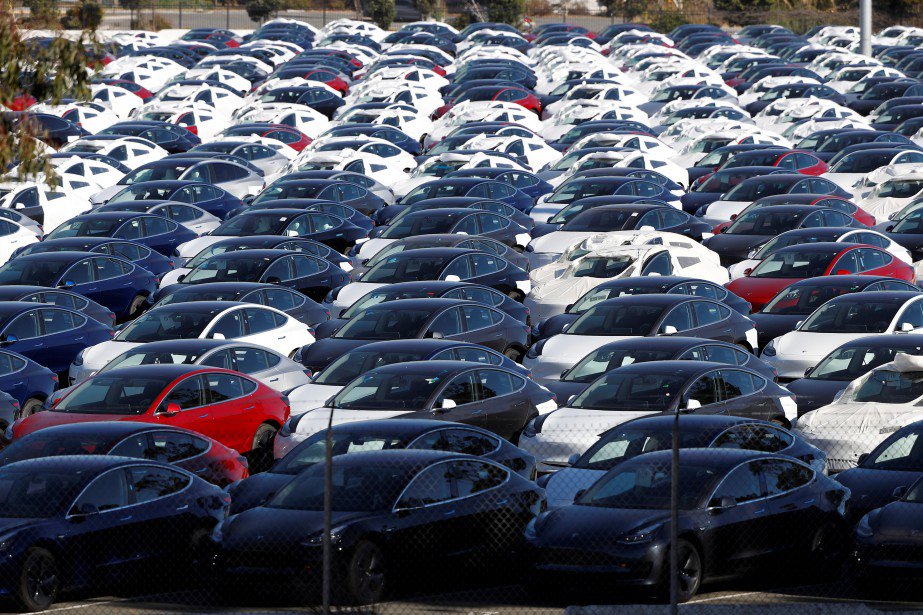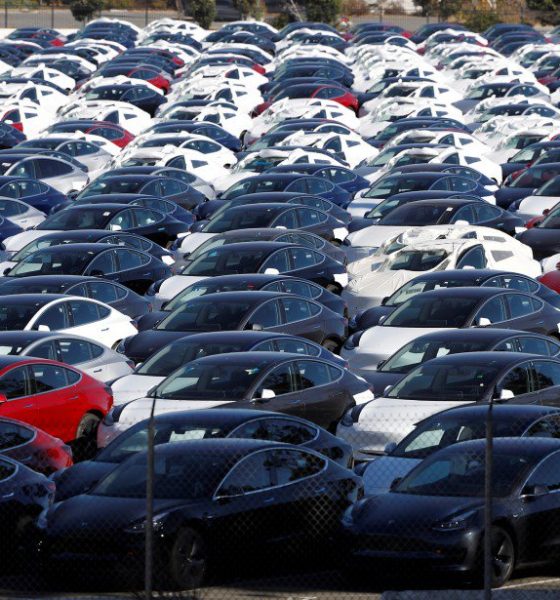

Investor's Corner
Tesla’s ‘delivery logistics hell’ is an encouraging sign for Q3’s Model 3 production
Tesla is now on full throttle as it attempts to deliver as many vehicles as it can to Model 3 reservation holders before the end of the third quarter. As the company hits new production levels for the electric car, Tesla is now finding itself facing yet another challenge — a new type of hell, even. As dubbed by Elon Musk in a recent tweet, Tesla has gone from “production hell” straight into “delivery logistics hell.”
Elon Musk was online this Sunday on Twitter, and during his interactions with his followers, he was faced with an inquiry from a Model 3 reservation holder whose delivery had been delayed multiple times. Megan Gale, the reservation holder, noted that her delivery date had been moved four times before she was informed that her Model 3’s handover had been delayed “indefinitely.”
Musk promptly admitted fault, stating that the company is currently facing challenges with delivery logistics. Musk did note, though, that delivery logistics hell is far more tractable than production hell; and thus, Tesla should be able to solve the issue shortly.
Sorry, we’ve gone from production hell to delivery logistics hell, but this problem is far more tractable. We’re making rapid progress. Should be solved shortly.
— Elon Musk (@elonmusk) September 17, 2018
While there are now reservation holders being inconvenienced due to Tesla’s inability to deliver their vehicles on time, the current issue does indicate something notably positive for one of the company’s targets this Q3 — the production numbers of the Model 3. Tesla has announced that it is aiming to produce 50,000-55,000 Model 3 for the third quarter, and just recently, an email from Elon Musk to the company’s employees noted that Tesla would likely build and deliver around twice as many vehicles as it did last quarter.
If Tesla is on track in meeting the milestones Elon Musk outlined in his letter, the company’s delivery centers across the United States are likely experiencing an influx of vehicles at a scale they have never experienced before. For a company that is still finding its legs as a mainstream carmaker, this sudden increase in the number of impending deliveries would likely result in challenges.
This is not to say that Tesla is being caught off guard by its own production numbers. This quarter, the company has implemented programs designed to speed up the delivery process, such as the 5-Minute Sign & Drive delivery program. Unlike Tesla’s old delivery system that involves a thorough walkthrough of its electric cars’ functions, the 5-Minute Sign & Drive system only covers the basics of the vehicles. The electric cars’ more specific features and capabilities are expected to be reviewed by reservation holders prior to the delivery date. Back in July, Elon Musk also noted that Tesla is working on a system that would get rid of paper contracts completely by having customers sign necessary documents online. Musk further noted that in the future, Tesla’s customers should be able to return the electric cars just like any other consumer product, in the event that they are unsatisfied with the vehicle.
There is a lot at stake for Tesla this third quarter. After achieving its then-elusive goal of manufacturing 5,000 Model 3 per week at the end of Q2 2018, the company has focused itself on the task of pushing Model 3 production even further and ending the quarter as a profitable company. These goals are undoubtedly ambitious, but Tesla seems to have a shot at accomplishing just that. Analysts from Evercore ISI and Worm Capital, for one, have noted that with the right optimizations, Tesla should be able to maintain a steady production rate of 5,000-6,000 Model 3 per week. The Evercore ISI analysts even noted that with minimal CapEx, Tesla should be able to manufacture up to 8,000 Model 3 per week.

Investor's Corner
Tesla stock closes at all-time high on heels of Robotaxi progress

Tesla stock (NASDAQ: TSLA) closed at an all-time high on Tuesday, jumping over 3 percent during the day and finishing at $489.88.
The price beats the previous record close, which was $479.86.
Shares have had a crazy year, dipping more than 40 percent from the start of the year. The stock then started to recover once again around late April, when its price started to climb back up from the low $200 level.
This week, Tesla started to climb toward its highest levels ever, as it was revealed on Sunday that the company was testing driverless Robotaxis in Austin. The spike in value pushed the company’s valuation to $1.63 trillion.
Tesla Robotaxi goes driverless as Musk confirms Safety Monitor removal testing
It is the seventh-most valuable company on the market currently, trailing Nvidia, Apple, Alphabet (Google), Microsoft, Amazon, and Meta.
Shares closed up $14.57 today, up over 3 percent.
The stock has gone through a lot this year, as previously mentioned. Shares tumbled in Q1 due to CEO Elon Musk’s involvement with the Department of Government Efficiency (DOGE), which pulled his attention away from his companies and left a major overhang on their valuations.
However, things started to rebound halfway through the year, and as the government started to phase out the $7,500 tax credit, demand spiked as consumers tried to take advantage of it.
Q3 deliveries were the highest in company history, and Tesla responded to the loss of the tax credit with the launch of the Model 3 and Model Y Standard.
Additionally, analysts have announced high expectations this week for the company on Wall Street as Robotaxi continues to be the focus. With autonomy within Tesla’s sights, things are moving in the direction of Robotaxi being a major catalyst for growth on the Street in the coming year.
Elon Musk
Tesla needs to come through on this one Robotaxi metric, analyst says
“We think the key focus from here will be how fast Tesla can scale driverless operations (including if Tesla’s approach to software/hardware allows it to scale significantly faster than competitors, as the company has argued), and on profitability.”

Tesla needs to come through on this one Robotaxi metric, Mark Delaney of Goldman Sachs says.
Tesla is in the process of rolling out its Robotaxi platform to areas outside of Austin and the California Bay Area. It has plans to launch in five additional cities, including Houston, Dallas, Miami, Las Vegas, and Phoenix.
However, the company’s expansion is not what the focus needs to be, according to Delaney. It’s the speed of deployment.
The analyst said:
“We think the key focus from here will be how fast Tesla can scale driverless operations (including if Tesla’s approach to software/hardware allows it to scale significantly faster than competitors, as the company has argued), and on profitability.”
Profitability will come as the Robotaxi fleet expands. Making that money will be dependent on when Tesla can initiate rides in more areas, giving more customers access to the program.
There are some additional things that the company needs to make happen ahead of the major Robotaxi expansion, one of those things is launching driverless rides in Austin, the first city in which it launched the program.
This week, Tesla started testing driverless Robotaxi rides in Austin, as two different Model Y units were spotted with no occupants, a huge step in the company’s plans for the ride-sharing platform.
Tesla Robotaxi goes driverless as Musk confirms Safety Monitor removal testing
CEO Elon Musk has been hoping to remove Safety Monitors from Robotaxis in Austin for several months, first mentioning the plan to have them out by the end of 2025 in September. He confirmed on Sunday that Tesla had officially removed vehicle occupants and started testing truly unsupervised rides.
Although Safety Monitors in Austin have been sitting in the passenger’s seat, they have still had the ability to override things in case of an emergency. After all, the ultimate goal was safety and avoiding any accidents or injuries.
Goldman Sachs reiterated its ‘Neutral’ rating and its $400 price target. Delaney said, “Tesla is making progress with its autonomous technology,” and recent developments make it evident that this is true.
Investor's Corner
Tesla gets bold Robotaxi prediction from Wall Street firm
Last week, Andrew Percoco took over Tesla analysis for Morgan Stanley from Adam Jonas, who covered the stock for years. Percoco seems to be less optimistic and bullish on Tesla shares, while still being fair and balanced in his analysis.

Tesla (NASDAQ: TSLA) received a bold Robotaxi prediction from Morgan Stanley, which anticipates a dramatic increase in the size of the company’s autonomous ride-hailing suite in the coming years.
Last week, Andrew Percoco took over Tesla analysis for Morgan Stanley from Adam Jonas, who covered the stock for years. Percoco seems to be less optimistic and bullish on Tesla shares, while still being fair and balanced in his analysis.
Percoco dug into the Robotaxi fleet and its expansion in the coming years in his latest note, released on Tuesday. The firm expects Tesla to increase the Robotaxi fleet size to 1,000 vehicles in 2026. However, that’s small-scale compared to what they expect from Tesla in a decade.
Tesla expands Robotaxi app access once again, this time on a global scale
By 2035, Morgan Stanley believes there will be one million Robotaxis on the road across multiple cities, a major jump and a considerable fleet size. We assume this means the fleet of vehicles Tesla will operate internally, and not including passenger-owned vehicles that could be added through software updates.
He also listed three specific catalysts that investors should pay attention to, as these will represent the company being on track to achieve its Robotaxi dreams:
- Opening Robotaxi to the public without a Safety Monitor. Timing is unclear, but it appears that Tesla is getting closer by the day.
- Improvement in safety metrics without the Safety Monitor. Tesla’s ability to improve its safety metrics as it scales miles driven without the Safety Monitor is imperative as it looks to scale in new states and cities in 2026.
- Cybercab start of production, targeted for April 2026. Tesla’s Cybercab is a purpose-built vehicle (no steering wheel or pedals, only two seats) that is expected to be produced through its state-of-the-art unboxed manufacturing process, offering further cost reductions and thus accelerating adoption over time.
Robotaxi stands to be one of Tesla’s most significant revenue contributors, especially as the company plans to continue expanding its ride-hailing service across the world in the coming years.
Its current deployment strategy is controlled and conservative to avoid any drastic and potentially program-ruining incidents.
So far, the program, which is active in Austin and the California Bay Area, has been widely successful.








